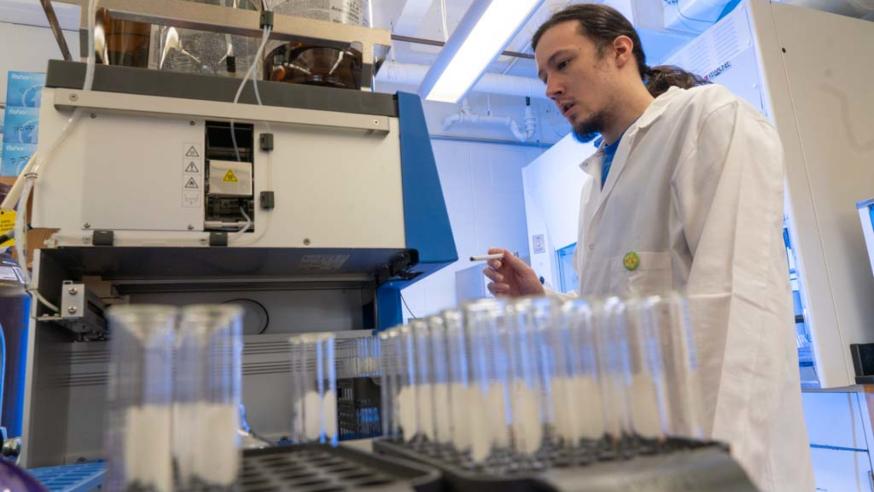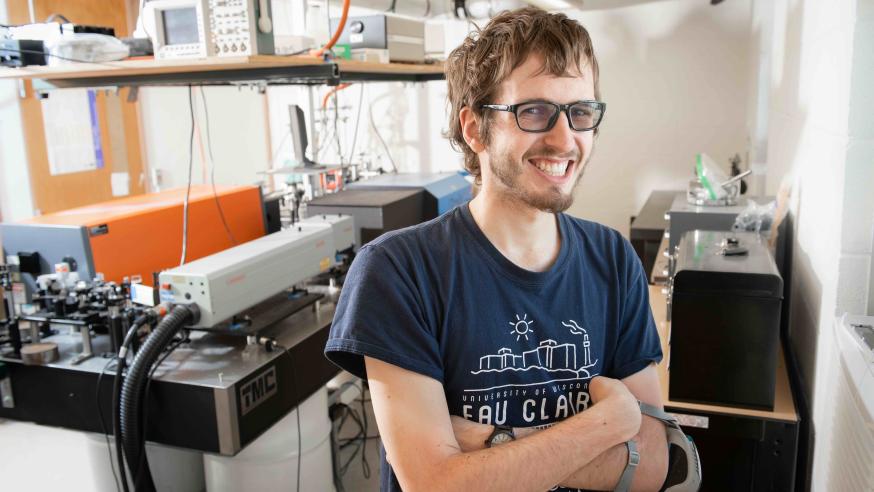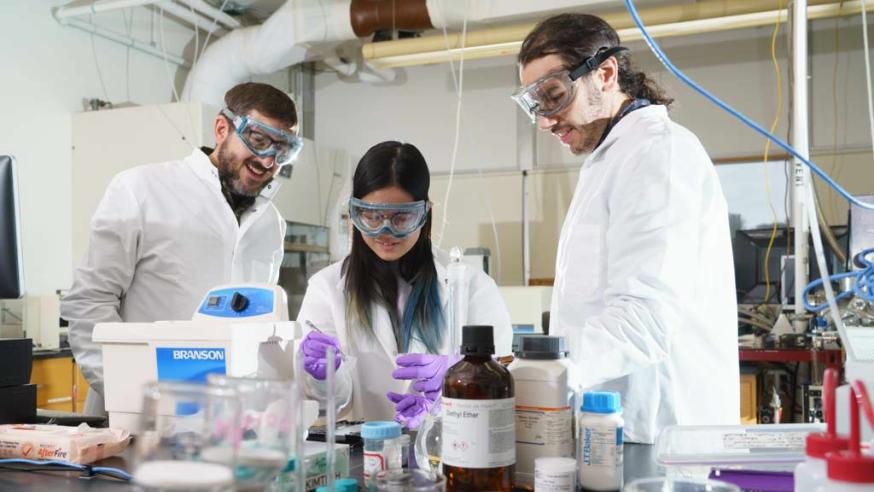Chemistry and Biochemistry Research

Learn, Earn, and Excel
Undergraduate research is more than just a priority for the Department of Chemistry and Biochemistry — it’s been part of our culture for over 60 years. Our first student-coauthored research manuscript published in 1960, and in the decades since our program has been established a national reputation as one of the strongest programs among public 4-year institutions for providing in-depth research experiences for undergraduates, supporting these experiences with external grant funding, and placing students in top graduate programs.
Participating in undergraduate research has numerous advantages beyond preparation for graduate school, it also provides hands-on training that prepares students for the workplace, and the experience is also highly valued by medical and dental schools. Research also enriches the college experience, enabling students to earn money and/or credit, qualify for Departmental Honors, and travel to conferences to present their work and confer with experts working on related projects. Many of our students publish their work research journals, which is a major resumé builder, and overall, the number student manuscripts we publish is yet another distinguishing feature of our program.
We have numerous opportunities to get involved in research, including both in-house internship opportunities in which students work directly with a faculty mentor, as well as course-embedded projects in which students engage in a research-based project in one of their classes.
The research in the Bhattacharyay group is inspired by the development of theoretical physical chemistry and computational science. Combining the growth of data science the new field of "Computational Chemistry" is producing significant discoveries in several fields of chemistry research. Supported by National Science Foundation grants, recent computational studies that have been published in peer-reviewed Chemical Society Journals include redox chemistry in COVID-19, spectroscopy of molecules, enzyme catalysis and mutations, enzyme functions in crowded environment, protein motions and functions.
This research incorporates ground-based and uncrewed aerial systems-based platforms for understanding the composition of the atmosphere. We participate in field campaigns to monitor air pollution and relevant meteorology during poor air quality events to better understand the relationship between air pollutants and air circulation in coastal environments.
Student researchers in Steve Drucker’s group are investigating what happens to molecules when they absorb ultraviolet light. This form of radiation is abundant in our environment, primarily coming from the sun. In Drucker’s lab, students use laser light to simulate what the sun does to molecules. When the molecules absorb laser light in the laboratory, the energy from the light can weaken the chemical bonds that hold the atoms together. This is the first step in the photochemical transformation of those molecules. By analyzing the specific wavelengths of light absorbed by the molecules, we can learn precisely how the bonds have been altered. Students use this quantitative information to test predictions of computational models. This benchmarking process ultimately permits refinement of the models. In the future, it is likely to be computational modelling that gives the most comprehensive information about photochemical processes.
Prof. Bart Dahl and his undergraduate student collaborators at the University of Wisconsin – Eau Claire are interested in the synthesis and study of new fluorescent dye molecules (chromophores) that can reversibly and rapidly change their optical properties in the presence of different stimuli including acids/bases and oxidants/reductants. These new compounds have practical applications as biological, environmental, and industrial sensors as well as possible components in nanoscale devices and switches.
Research projects in Dr. Jennifer Dahl’s laboratory are focused on the synthesis of nanoscale components to create organic-inorganic composite films. These ultrasmall “building blocks” are then organized within a Langmuir trough via interfacial reactions. Restricting the reactions to air-water or hydrophobic liquid-water interfaces forces the nanoparticles into an ordered monolayer assembly, and the identity of the small organic molecules governs the physical and mechanical properties of the thin film products. The films have unique optical and electronic properties, making them useful for next generation devices and coatings.
Prof. Doyon and his group are interested in using enzymes (also known as biological catalysts) to perform organic reactions. Specifically, the Doyon group uses enzymes to break down chemical waste products and make new, valuable molecules. The goal of the group is to “upcycle” these materials and simultaneously break down persistent environmental pollutants. In the Doyon group, students can get valuable experience performing organic reactions and learn important biochemistry techniques, such as enzyme purification and characterization. Students also learn about the amazing chemical reactions that can be performed by enzymes.
Several synthetic projects are at the heart of the Gerlach Research Group that include emphasis on organic synthesis of unique asymmetric tridentate ligands and inorganic synthesis of metal complexes featuring those ligands. Our synthesis is supported by analytical and spectroscopic techniques which are also employed to define the electronic and structural features these organometallic complexes utilize in catalysis. In addition, an ongoing industrial collaboration with WPC Technologies is underway to assist in formulation design of non-chrome based anti-corrosive pigments.
Dr. Sanchita Hati's research group employs chemical, biochemical, and molecular biology techniques, spectroscopic methods, and computational modeling to investigate biomolecules for drug development and disease diagnosis. Undergraduate students in her research group develop hands-on laboratory skills while deepening their understanding of fundamental biochemical and biophysical concepts. The experience and skills acquired through participation in her research projects lead to preparedness for the workforce and opportunities to thrive in graduate and professional schools.
Electrochemistry is the study of chemical reactions that involve electron transfer. Most chemical reactions that are relevant to our society’s modern energy issues involve electron transfer, including reactions in batteries, solar panels, fuel cells for hydrogen-powered cars, and carbon fixation technologies. Students in the Knoche Gupta group use electrochemical techniques to study catalysts for these important electrochemical reactions.
In the Phillips group, we investigate structure and bonding in systems called “molecular complexes” — which simply refers to a situation in which two stable molecules are stuck together either by weak, physical forces, or a bona fide chemical bond. Certain classes of complexes have novel properties, which challenge basic ideas about the theory of chemical bonding. Our particular focus is on systems which undergo dramatic structural changes when they are shifted from one chemical environment to another (e.g., from the gas phase to solution).
Experiments involve trapping complexes in ultra-low temperature environments; so-called “noble gas matrices”- samples of neon argon, or nitrogen held at temperatures near absolute zero. There we measure the resonant frequencies of the bonds, from which we in for the strength of the interactions in the complexes. We also conduct a wide range of theoretical calculations that inform us about the underlying physical factors that manifest this unique bonding.

Recent & Active Grants
“Non-Chrome Corrosion Inhibitor Pigment Dispersion”
Senior Personnel: Dr. Deidra Gerlach & Dr. Kristi Knoche-Gupta,
U.S. Department of Defense, 9/1/23 - 8/31/25, $411,758.
“RUI: Condensed-Phase Effects on the Structural and Energetic Properties of Nitrogen Donor SOx Complexes”
Principle Investigator: Phillips, James A.
National Science Foundation (CSDM-A), 9/1/22 - 8/31/25, $313,276
"Method for the selective synthesis of chiral adipic acid derivatives using ene-reductases”
Principle Investigator: Dr. Tyler Doyon
WiSys, 5/15/24 - 8/31/24, $10,000.
“WiscAMP Academic Leadership Fellows at UWEC” (Modification 5)
Principle Investigator: Dr. Patricia Cleary
UW-System, 9/1/23 - 8/31/24, $12,000.
“Providing lower atmospheric observations during AEROMMA Chicago area flights using unmanned aerial vehicles”
Principle Investigator: Dr. Patricia Cleary
Lake Michigan Air Directors Consortium (LADCO), 7/1/23 - 6/30/24, $19,736.
“Surface-Enhanced Raman Spectroscopy of Human Saliva as a Non-invasive Tool for Cancer Diagnostics”
Principle Investigator: Dr. Sanchita Hati
Mayo Clinic-UWEC, 10/19/22 - 5/31/24, $24,928.
“Exploring the Dynamics of Prolyl-tRNA Synthetases: Towards Developing a Screening Method for Species-Specific Inhibitors”
Principle Investigators: Dr. Sudeep Bhattacharyay & Dr. Sanchita Hati
National Institute of Health-Academic Administrative Supplements for Equipment for Select NIGMS-Funded Awards, 2023-2024, $99,900.
“REU Site: Advancing High-Performance Computing Opportunities in Undergraduate Research at UW-Eau Claire to Meet Challenges of Multidisciplinary Computational Science”
Co-PI: Sudeep Bhattacharyay (with Rahul Gomes of Computer Science)
National Science Foundation (NSF-REU), 2022-2024, $385,762.

Recent Publications
* Indicates UWEC Student co-authors.
"Conformational Fluidity of Intrinsically Disordered Proteins in Crowded Environment: A Molecular Dynamics Simulation Study"
Shult, C.*, Gunderson, K.*, Coffey, S. J.*, McNally, B.*, Brandt, M.*, Smith, L.*, Steczynski, J.*, Olerich, E. R.*, Schroeder, S. E.*, Severson, N. J.*, Hati, S. and Bhattacharyya, S.
J. Biomol. Struct. Dyn. 2024, 1-13.
DOI: https://doi.org/10.1080/07391102.2024.2404531.
"Polyethylene Glycol Impacts Conformation and Dynamics of Escherichia coli Prolyl-tRNA Synthetase via Crowding and Confinement Effects"
Liebau, J.*, Laatsch, B. F.*, Rusnak, J.*, Gunderson, K.*, Finke, B.*, Bargender, K.*, Narkiewicz-Jodko, A.*, Weeks, K.*, Williams, M. T.*, Shulgina, I.*, Musier-Forsyth, K., Bhattacharyya, S., and Hati, S.
Biochemistry 2024, 63, 1621-1635.
DOI: https://doi.org/10.1021/acs.biochem.3c00719.
“Observing low altitude features in ozone concentrations in a shoreline environment via Unmanned Aircraft Systems”
Radtke, J.,* Kies, B*, Koerber, K.*, Mottishaw, W.*, Voon, A.*, Zeuli, S*. Petty, G., Vermeuel, M., Bertram, M., Desai, A., Wagner, T., Pierce, R.B., Hupy, J.,
Cleary, P.A.†
Atmospheric Measurement Techniques 2024, 17, 2833-2847.
https://doi.org/10.5194/amt-17-2833-2024
"Writing a Literature Review as a Class Project in an Upper-Level Undergraduate Biochemistry Course"
Hati, S. and Bhattacharyya, S.
Biochem. Mol. Biol. Educ. 2024, 1-6.
DOI: https://doi.org/10.1002/bmb.21814.
"High-performance computing in undergraduate education at primarily undergraduate institutions in Wisconsin: Progress, challenges, and opportunities"
Hebert, J.*, Hratisch, R.*, Gomes, R., Kunkel, W., Marshall, D., Ghosh, A., Doss, I.*, Ma, Y., Stedman, D., Stinson, B., Varghese, A., Mohr, M.*, Rozario, P.* Bhattacharyya,S.
Educ. Inf. Technol. 2024.
DOI: https://doi.org/10.1007/s10639-024-12582-6.
"Use of an Integrating Cavity Spectrometer to Easily Determine Beer SRM Color Without Filtration, Centrifugation or Numerical Correction"
Brandt, M.*, Hau, N.*, Laatsch, B.F.*, Torti, A.*, Berthiaume, A.R.*, Kaat, G.M.*, Marcotte, E.M.*, Shepler, M.L.*, Smith, L.S.*, Snyder, K.L.*, Stepanek, J.M.*, Tichy, S.K.*, and Bailey-Hartsel, S.C.
Journal of the American Society of Brewing Chemists 2023.
DOI: 10.1080/03610470.2023.2209224
"The Chemical History of Color, but just two kinds of them"
Lewis, D.E.
Bull. Hist. Chem. 2023, 48, 39-49.
"A Dark Comedy of Errors: Nierenstein, Freudenberg and the Structure of Catechin"
Brock, W. H., Lewis, D. E.
Bull. Hist. Chem. 2023, 48, 170–1891.
"Early organic chemistry in Kyiv: Serhii Mykolayovych Reformatskyi (1860–1934) and his name reaction"
Lewis, D.E.
ChemPlusChem 2023, 88 (10), e202300224.
"Insight into the Mechanism of Tryptophan Fluorescence Quenching due to Synthetic Crowding Agents: A Combined Experimental and Computational Study"
Fossum, C. J.*, Johnson, B.O.V.*, Golde, S.T.*, Kielman, A.J.*, Finke, B.*, Lowater, H. R.*, Laatsch, B.*, Bhattacharyya, S. and Hati, S.
ACS Omega 2023, 8, 144820-44830.
DOI: https://doi.org/10.1021/acsomega.3c06006
"Jet-Cooled Phosphorescence Excitation Spectrum of the T1(n,π*) ← S0 Transition of 4H-Pyran-4-one"
Parsons, S.W . *, Hucek, D.G. *, Mishra, P., Plusquellic, D.F., Zwier, T. S., & Drucker, S.
J. Phys. Chem. A. 2023, 127, 3636-3647. DOI: https://doi.org/10.1021/acs.jpca.3c01059
"Polyethylene Glycol 20k. Does It Fluoresce?"
Laatsch, B.F. *, Brandt, M.*, Finke, B.*, Fossum, C.J. *, Wackett, M.J. *, Lowater, H.R. *, Narkiewicz-Jodko, A. *, Le, C. N.*, Yang, T., Glogowski, E.M., Bailey-Hartsel, S.C., Bhattacharyya, S., and Hati, S.
ACS Omega 2023, 8, 14208–14218.
DOI: https://doi.org/10.1021/acsomega.3c01124
"Leaf senescence alters Ambient BVOC over a mixed temperate forest"
Vermeuel, M.P., Novak, G.A., Kilgour, D.B., Clafin, M.S., Lerner, B.M., Thom, J., Cleary, P.A., Desai, A.R., Bertram, T.H.
Atmospheric Chemistry and Physics 2023, 23, 4123–4148.
DOI: https://doi.org/10.5194/acp-23-4123-2023
"Observations of Coastal Dynamics During Lake Breeze at a Shoreline Impacted by High Ozone"
Tirado, J. *, Torti, A.*, Butterworth B.*, Wangen, K.*, Voon, A. *, Kies, B. *, Hupy, J. de Boer, G., Pierce, R.B., Wagner, T. J., Cleary, P.A.
Env. Sci. Atmos. 2023, 3, 494-505.
DOI: 10.1039/D2EA00101B
"Does Beer Obey Beer’s Law?"
Benning, T.*, Lowater, H.* and Bailey-Hartsel, S.C.
MBAA Technical Quarterly 2023, 60:3, 63-65.
DOI: https://doi.org/10.1094/TQ-60-3-1005-01